Only inklings of inspiration on your next Construct innovation? Fret not all ye Artificers, Magi-tech inventors, and spell weavers! Nothing shows off the craft and talent of the realms like Constructs!
Consider this your Constructs 5e guide through my showroom of the Forgotten Realm’s finest inventions.
Great golems of war capable of taking on the Terrasque itself!
Horrifying death machines crafted by DEVILS!
Why, even crafty little creations worthy of a proper Fey-Prank!
Now isn’t that a truly terrifying testament? Well, let me prove it with this Manufactured Museum!
Constructs Catalogue
Rule Books: Monster Manual (MM), Monsters of the Multiverse (MotM), Explorer’s Guide to Wildemount (EgtW), Guildmaster’s Guide to Ravnica (GgtR),
Adventure Books: Candlekeep Mysteries (CM), Curse of Strahd (CoS), Eberron: Rising from the Last War (ERftLW), Ghosts of Saltmarsh (GoS), Icewind Dale (ID), Waterdeep: Dungeon of the Mad Mage (WoMM), Wild Beyond the Witchlight (WbtW),
| Construct | Challenge Rating | Book |
| Animated Armor/Objects | ¼ to 2 | MM |
| Baba Lysaga’s Creeping Hut | 11 | CoS |
| Bore Worm | 16 | WoMM |
| Cadaver Collector | 14 | MotM |
| Chardalyn Dragon | 11 | ID |
| Expeditious Messenger | 1/8 | ERftLW |
| Golem | 2 to 16 | MM / WbtW |
| Hellfire Engine | 16 | MotM |
| Homunculus | 0 | MM |
| Living Doll | 2 , 5 | WbtW / CoS |
| Living Spell | 0 , 8 | ERftLW / ID |
| Living Statue | 5 to 8 | GoS |
| Marut | 25 | MotM |
| Modron | ⅛ to 2 | MM |
| Scarecrow | 1 | MM |
| Skitterwidget & Kiddywidget | ½ , 5 | CM |
| Thrull | ¼ , ½ | GgtR |
| Tomb Tapper | 10 | ID |
| Warforged Titan & Colossus | 8 , 25 | ERftLW |
Constructs Condensed
Do not let the name fool you; this is not steampunk. The innovation of the modern world still touches Constructs due to us writing it in modern times. However, that doesn’t mean we can’t strip away the circuitry and coding with magic and hubris!
Constructs in DnD are typically made through intense practices of magic, weaved in a complicated fashion using several means based on the specialty of the creator. Therefore, it requires a high level of skill in all crafts involved.
This can be through a ritual, more practical methods such as ironworking while using magic reagents, whatever Primus’ math magic is up to, and even the taboo art of shoving soul A into object B.
Most constructs feed off of the weave or some other fuel source without the need to otherwise eat, drink, sleep, or maintain themselves. Most constructs obtain their fuel source through passive behaviors.
Thanks to the nature of magic, Constructs firmly obey the will of their creators.
Manufactured Museum: Animated Armor/Object

- Book: Monster Manual
- Challenge Rating: ¼ (Flying Sword), 1 (Animated Armor), 2 (Rug of smothering),
- Creation Method: 5th Lvl Spell (Bard, Sorcerer, Wizard)
The caster can choose up to ten small nonmagical objects within 120 feet that are not worn or carried. To allow for a mixture of different sized things, with a medium object counting for two, large counting as four, and huge counting as eight.
The spell caster can not animate larger objects. These objects require concentration to manipulate, can only be animated for up to a minute, and can be used to attack with damage based on their size category.
With rituals, magical construction, and more permanent spells, a spellcaster can animate objects for vastly more prolonged periods. One such example is a Rug of Smothering.
These objects were indistinguishable from regular rugs and often used as traps. However, Rugs of Smothering are also capable of cutting off your oxygen by wrapping you up and slowly crushing you in their grasp.
Baba Lysaga’s Creeping Hut
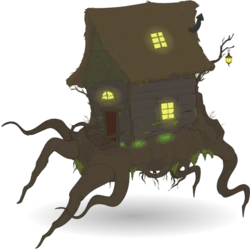
- Book: Curse of Strahd
- Challenge Rating: 11
- Inventor: Baba Lysaga
Not only is Baba Lysaga one of DnD’s OG witches, complete with Baba Yaga tendencies, but she is also the midwife of Strahd von Zarovich.
One who saw his potential for evil while tending to the newly birthed horror and one who would be far more influential than his actual mother in the coming days. Lysaga is a crucial character in Ravenloft’s lore and adventure. Lysaga brought herself unholy power just to see the rise of the son of evil she had formed.
So, understanding aesthetics is essential in raising an evil tyrant; Lysaga went with the Baba Yaga Classic. A Hut with chicken legs. A magic stone is said to be at the heart of its control.
It will fight even after Lysaga falls until the stone is removed or the Hut itself is conquered. If left to roam wild and free. It will become a destructive menace as it is mad it lost its creator.
The Encounter with Baba Lysaga almost always involves also fighting her Hut. This Hut is not a gentle creature. Sadly it is made of wood and plant matter, so the being built like a brick house joke falls flat here.
Much like a party fighting Lysaga, the Hut, a bunch of Lysaga’s scarecrows, and all the animated objects she has scampering about!
Bore Worm

- Book: Waterdeep: Dungeon of the Mad Mage
- Challenge Rating: 16
- Inventor: Metal Mage Trobriand
The Bore Worm was created by Trobriand, a wizard mastering the art of ‘Metal Magics.’ In the converted Dwarfhold, Trobriand acts as one of the seven apprentices of the ‘Mad Mage’ Halaster Blackcloak. With a limited trust of humans, Trobriand considers his creation to be superior beings.
The bore worm was made in the image of a Purple worm. However, it is far larger and has horrendous grinding spiked gears which act as its teeth. Also, it was made of an unknown material that could only be damaged by Adamantine.
It was primarily used to create a massive network of tunnels throughout Undermountain. When not ordered to build new tunnels, it would patrol the excavated tunnels, grinding any Trobriand might consider an invasive headache.
Cadaver Collector
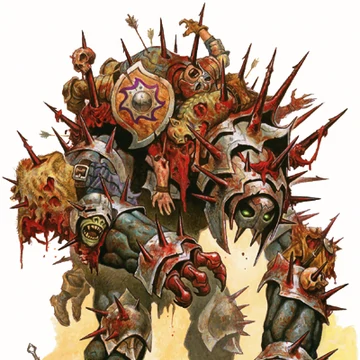
- Book: Monsters of the Multiverse
- Challenge Rating: 14
- Creation Method: Ancient creations, users typically summon them
In the Outer Planes, there is a Plane representing that gray area between Lawful Evil and Lawful Neutral. It acted as the bridge between the nine Hells and Nirvana. The Infinite Battlefield of Acheron is what happens if the dream of Valhalla spoiled a little.
Endless battlefields stretched across geometric blocks the size of nations crashing about, covered in warring armies. Many the gathered dead believers of many gods. This is the home of the eternal war between the Goblinoid and Orc deities, among many other rivalries.
Such a place NEEDS a cleaner. So while the origins of the Cadaver Collector aren’t well known, their purpose is.
In their natural state, these ancient constructs lumber around Archeron, collecting the fallen corpses of the endless armies of countless kingdoms. Looking like idly insectoid Iron Golems with spikes jutting from their back, Cadaver Collectors are covered in the weapon and armor of their collected foes.
They casually take their swords and spears, using them to pin the corpse to their body before carrying on.
Corpses are skewered on these large constructs, with plenty of room for a grisly battalion of decaying corpses to be left on their back. These corpses aren’t just accessories, though they do give Acheron that particular spice.
Imagine seeing mountains of metal and flesh moving through the battlefields like mobile cemeteries. Plucking anyone that looks even remotely ‘corpse-like’ to shove onto their backs. These corpses are weapons.
A Cadaver Collector can summon a nearly endless supply of specters using these corpses if given enough time. Their body and spirit are bound to war, and now they’re bound to the Cadaver Collector.
These constructs can be summoned to the Material Planes by a mortal at the scene of a great battle. Be it imminently brewing, actively churning, or cleaning up the rotten overflow.
Once summoned, these constructs must be dismissed back to Acheron. Otherwise, they will linger at the whim of their summoner or wander the material plane collecting corpses in a hunt for a way back home.
Chardalyn Dragon
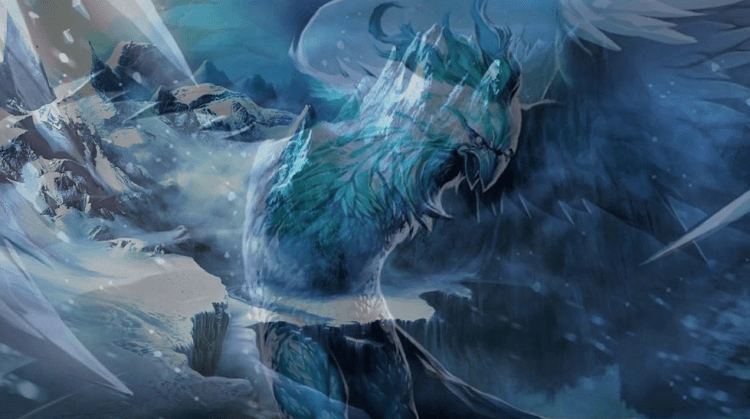
- Book: Icewind Dale
- Challenge Rating: 11
- Creation Method: Built using the rare gem, Chardalyn
A rare Dragon-Shaped construct. It’s as vicious and corruptive as a Shadow Dragon. This is primarily thanks to the rare material making the bulk of its form.
The body of a Chardalyn Dragon is made of pieces of Chardalyn, a rare but powerful gem. However, their wing flaps are made of an oily film that is tough as rubber when the dragon is ‘powered.’
Chardalyn is, by nature, demonic. Demonic magic radiates from it, and due to this, the construct is cruel and twisted by nature. Furthermore, it will corrupt any target that gets anywhere near it with its corruptive radiance.
Only the most twisted of artificers and spell crafters use Chardalyn, much less make giant dragons out of it. These creations are blindly loyal. These dragons will gladly destroy themselves to serve their master’s whim.
Expeditious Messenger
- Book: Eberron: Rising from the Last War
- Challenge Rating: 1/8
- Creation Method: NPC, or ask your DM nicely
They are designed to carry messages quickly, using bodies built for expeditious flight. They come in multiple physical forms, but they share one adorable, or annoying, trait.
They natter on incessantly. As constructs built not only to be quick, but also deliver messages, and roam, they can chatter away about anything thanks to their latent 8 Int and 12 Wis combined with speaking their creator’s language.
These are cute little constructs with the valuable ability to not evoke an attack of opportunity when it flies out of the energy’s threat range. This lends itself to players and DMs alike when needing to get a message or, possibly, an enchantment off without interruption.
Golem
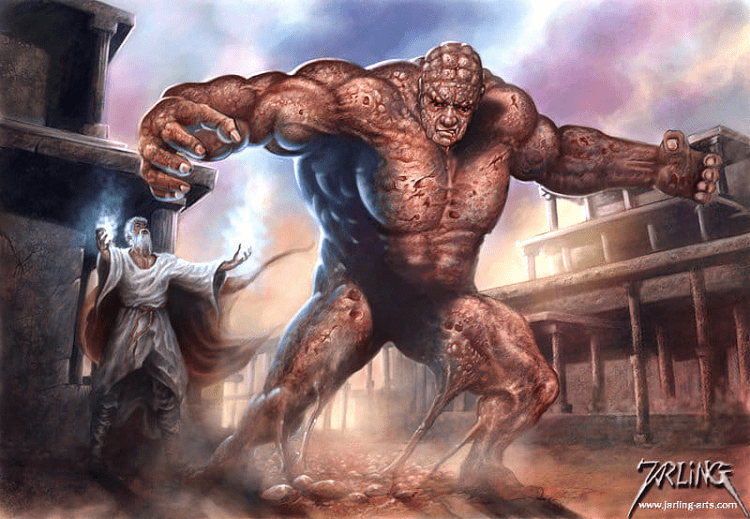
- Book: Monster Manual, Wild Beyond the Witchlight
- Challenge Rating: Glasswork (2, WbtW), Flesh (5, MM), Clay (9, MM), Stone (10, MM), Iron (16, MM)
- Creation Method: Magic Construction, Ritualistic Surgery (Flesh)
A golem is made from humble materials, but it becomes an unstoppable behemoth through magical construction. As a result, it is one of the go-to constructs for any spellcaster or scientist in need of filling their ranks while showing off their craft.
A golem’s body requires a singular resource connected to the Elemental Plane of Earth. For example, iron must be forged with ironworking, stone via stonecutting, flesh by flesh crafting, or surgery.
Why Flesh? I don’t know; I could argue it is all the elements based on how you view it. The point is this next step. Flesh classifies as long as the body is made from six different sources, each making up the bulk of the head, limbs, and torso, respectively.
However, the creator who the golem will obey the commands of must be able to bind an Earth Elemental to the newly constructed body. The creator doesn’t need to be a master of crafting, as they can hire another to make the body.
A Golem whose master has been killed will either go into stasis to blindly continue following its ‘pre-programmed orders. Yet, there are methods of harnessing these golems for your own benefit.
Hellfire Engine

- Book: Monsters of the Multiverse
- Challenge Rating: 16
- Inventors: Devil Generals, Amnizu specifically
These horrific tanks come in many shapes and sizes, but they all look like a gate to one of the Nine Hells with wheels and claws. Sometimes, their forms are inspired by the most insidious and terrifying of Devils to further terrify their victims.
Hellfire Engines are living machines built with an instinct to destroy fuel by the ever-growing rage of the soul built around it.
While just moving through the Battlefield, the Hellfire Engine was capable of crushing enemies under its weight. Devils being craft but orderly about it also fit the Hellfire Engine with the latest in torturous weaponry.
Their shell is often decked out with acid sprayers, lightning flails, and cannons.
However, its most devilish weapon was what happens to those slain by the Hellfire Engine. It became trapped in the roaring furnace, giving the living machine the briefest bit of satiation from its eternal torment. Seconds worth, but fantastically fleeting.
These souls are transformed by the Hellfire Engine into Lemures (low-ranking devils) within a matter of hours. Once the soul is finished being forged into a devil, only Wish or True Resurrection will restore it to its former form.
They are constantly being modified to increase their efficiency and terror potential. Currently, Devil Scholars are rapidly seeking solutions to improve their soul-converting technology to work on demons.
The Blood War never changes, but their weapons sure do.
Homunculus
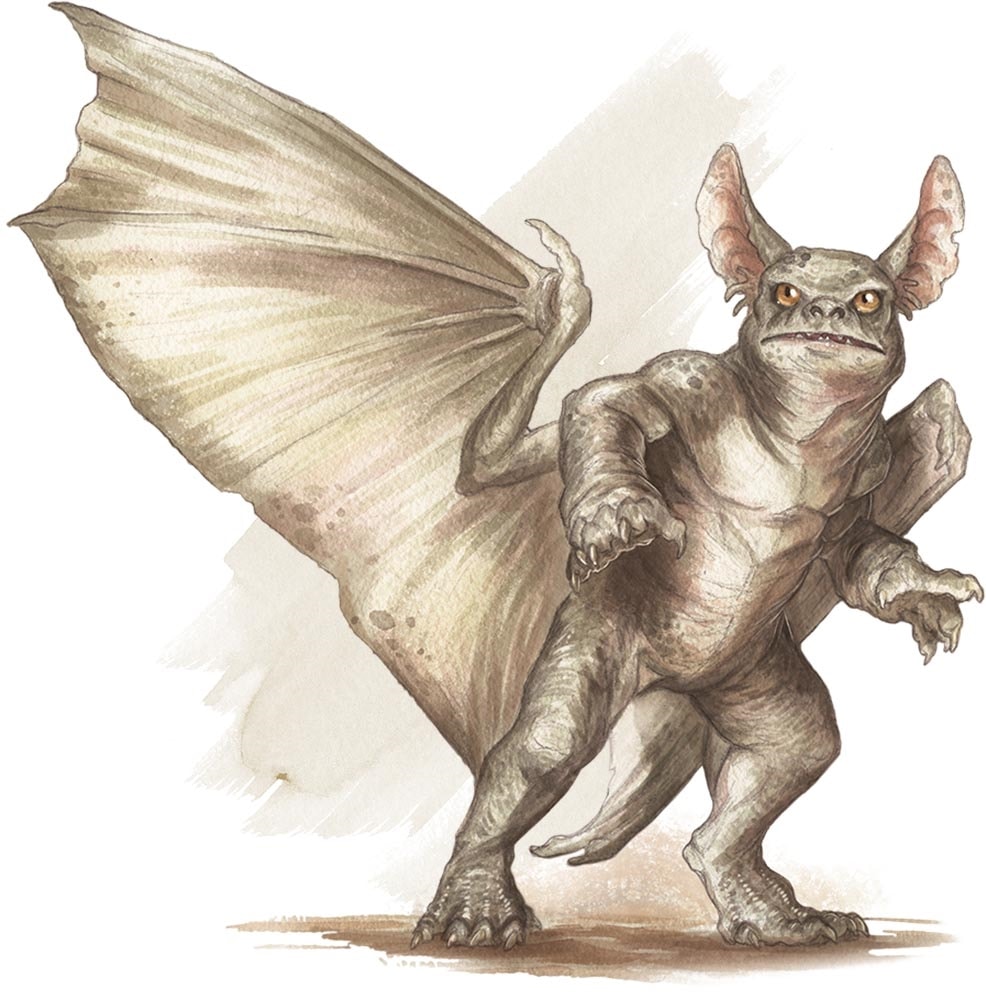
- Book: Monster Manual
- Challenge Rating: 0
- Creation Method: Sculpted from a mixture of clay, ash, mandrake root, and water collected from a natural source
Homunculus can look however their creators craft them so long as they do it correctly, in the right place, and with the right blood. 1 Pint of the creator’s blood is needed to be brought to life using a ceremonial dagger costing no less than 1,000 in gold. If their creator dies, so will the Homunculus.
They usually end up looking like squirrel-sized bulldog dragons. The reason is that a level of whimsy is required to be a spell caster, and we all like nice things sometimes.
While they could be crafted for specialized use, their size meant they were usually used as spies, familiars, or servants. Also, decking them out in cute clothing is optional but recommended.
Living Doll
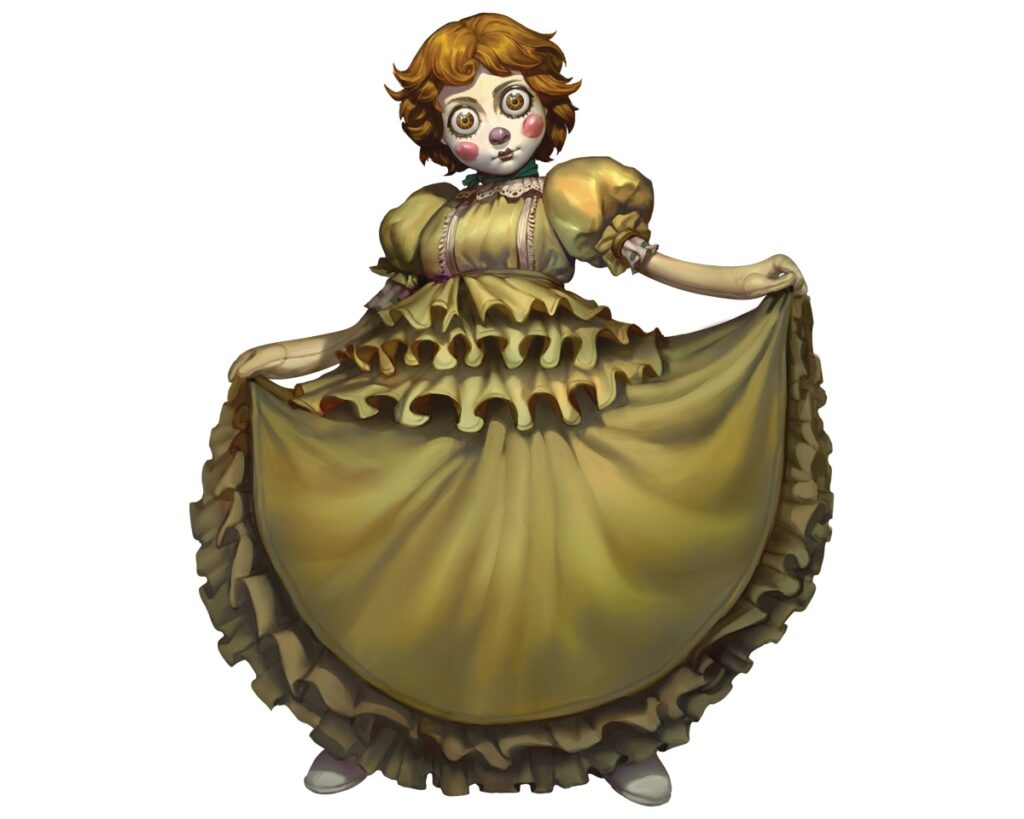
- Book: Wild Beyond the Witchlight, Curse of Strahd
- Challenge Rating: Living Doll (2, WbtW), Pidlwick II (5, CoS),
- Creation Method: A ‘mean spirit’ trapped within a doll or toy as a vessel. The typical method is being cursed to stay in a doll through ritual exorcism
Living Dolls can be easily mistaken for one of their inanimate cousins. They can be made of any material a doll might. Theoretically, any toy could be classified as a ‘living doll.’
The critical reagent is the trapped soul. A mean spirit, either by choice or curse, is trapped within this vessel, creating a tiny construct. Much like a mean-spirited Hag, a Living Doll takes pleasure in encouraging lousy behavior.
They even have their preference for torment, like a hag. A Living Doll finds the most pleasure in hastening the descent of depression and paranoia. They like tormenting the guilt-ridden and despondent into acts they would never have thought themselves possible off.
Defensively, it uses maniacal cackles to unsettle its attacker before thrusting them into a nightmare by pitting their worst fears against them.
Then it does that horror movie doll giggle about that whole thing. All in all, very Fey.
Living Spell

- Book: Eberron: Rising from the Last War & Icewind Dale
- Challenge Rating: Demiplane (0, ID), Burning Hands (1, ERotLW), Bigby’s Hand (4, ID), Lightning Bolt (5, ERotLW), Cloudkill (7, ERotLW), Blade of Disaster (8, ID),
- Creation Method: Formed by Eldritch or Wyld disruption, the largest source is the Last War
Just as the name implies, the spell is living and has opinions about that. Living spells are sapient forms of a single spell, permanently stuck in this world and constantly leaving its spell effects as if continuously cast.
As these spells tended to lurk or haunt areas of Eldritch or Wyld energies, information added by Icewind Dale, these creatures are likely constructed out of the weave’s distortion. The Cataclysm of the Last War is the root cause of these anomalies. Still, other sources have been formed, specifically wizards who decided to study these forces.
They exist on magical energy. Though Living Spells don’t need to attack the living for food, they will still aggressively attack anything around them, thanks to their distorted and wild nature.
Customizing a Living Spell
Eberron includes rules on changing a spell of your choice into a Living Spell. I will summarize them here.
- Type: Living spells usually manifest from damage-dealing evocation and conjuration spells.
- Levels: 1-5; any higher would create an entirely different beast. Consult the table below.
- Damage Immunity: Replace with the type of damage the chosen spell deals.
- Magical Strike: Replace damage dealt with type dealt by the chosen spell.
- Spell Mimicry: Add or replace any DC’s, Attack bonuses, effects, and saving throws on the given stat block with those from the new chosen spell.
The book offers three included stat blocks for you to modify based on the spell’s level. Links were personally verified using the official source.
| Chosen Spell Lvl | Stat Block to Customize |
| 1-2 | Living Burning Hands |
| 3-4 | Living Lightning Bolt |
| 5 | Living Cloudkill |
Living Statues
- Book: Ghosts of Saltmarsh
- Challenge Rating: Iron (5), Minotaur (6), Vampiric Jade (8)
- Creation Method: Magical Ritual or Spell involving a Statue
While there isn’t much lore on them, there are stat blocks, which is the important bit! Living Statues are a magic-construct staple. So knowing where the stat blocks to them are is essential. You never know when you’ll need them, and I wrote this guide to be thorough.
Living Statues act like golems but are left dormant and decorative as traps for unwitting adventurers or thieves. Their construction material dictates their strength and abilities, while their shape and design dictate their fighting prowess.
Marut

- Book: Monsters of the Multiverse
- Challenge Rating: 25
- Inventors: Mystra, Mother of All Magic
Horrific humanoids in visage, mechanical magic in form. They were crafted by the one god you never mess with under Ao, Mystra. Maruts enforce the inevitability of death and the certainty of contracts.
The Marut comes when you have denied death in the most extreme methods.
Maruts targetted the unnatural. Lichdom, those who sacrifice their kingdoms to save themselves, or extremely excessive use of resurrection magic will bring the ire of the Marut.
Sometimes, influential leaders could use sigils empowered by a Marut to show the depths of the contract. So, should either party fail to accept the terms of the agreement, a Marut’s ire will be summoned.
The Marut is determined and unwavering in their duties as an Inevitable. There is no changing their mind; they only follow Mystra’s whim and the letter of the contracts they are involved in. They can detect lies and are highly skilled and intelligent constructs. Also, surprisingly, avid scholars of religious lore.
A Priest of Mage honoring the progression and innovation of magic may summon a Marut via a Call Marut spell. This is a 9th-level spell available to Clerics, Sorcerers, Wizards, and the rare Mechanus spell users (Modron Hierarchs)
With the 8th level spell Unyielding form of inevitable death, Sorcerers and Wizards can transform themselves into a Marut with a semblance of its power.
The Inevitables
The Marut is the most well-known of the Inevitables. These Lawful Constructs were created by Mystra to assist her in her duties governing the laws of magic. They were tasked as governors of the fundamental laws of magic. Which in the Forgotten Realms include the Laws of Physics and the Universe’s structure as a whole.
Other Inevitables include the Kolyarut, Quarut, Varakhut, and Zelekhut.
Modron

- Book: Monster Manual
- Challenge Rating: Monodrone (⅛), Duodrone (¼), Tridrone (½), Quadrone (1), Pentadrone (2), Heirarch (N/A)
- Inventor: The Mad God Primus
- Creation Method: They are created in the Modron Cathedral in Mechanus
Modrons are the creation of the mad god Primus. They are an entire species of orderly creatures that act as the native inhabitants of the Outer Plane representing Lawful Neutrality. Modrons are a mixture of Biological and Mechanical materials, which gets increasingly more advanced and biological as the Modrons go up in rank.
The rest of the Outer Planes know them as those weird creepy things that march through all their planes in a clockwork fashion no matter how much they kill them. Every 289 years, like clockwork.
Scarecrow
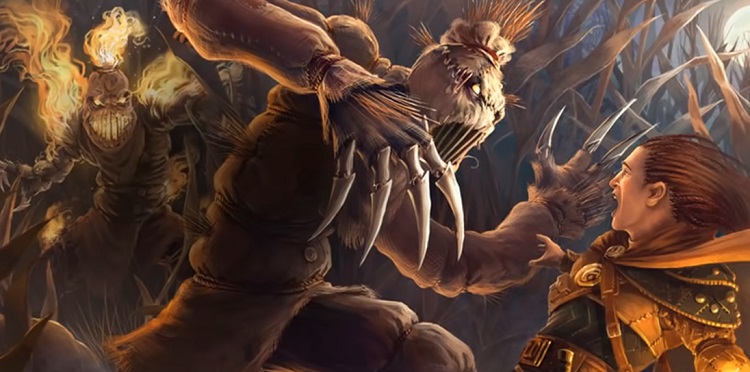
- Book: Monster Manual
- Challenge Rating: 1
- Inventor: Baba Lysaga
- Creation Method: A spirit bound to an object
The Scarecrow is a fan-favorite minion to the Hags and Witches of the Forgotten Realms. The trick is that the spirit shoved into its constructed host must be evil. The Scarecrow also involves sackcloth getting used in the making of the rough shape of a humanoid.
Merely seeing a Scarecrow is enough to petrify a party member. Mainly as they watch a swarm of them tear their dear friend limb from limb. They are your stable construct made to do nothing but murder your adventurers. But, when they aren’t, they will happily provide a haunting aesthetic for a hearty harvest.
Hags and witches had been noted as preferring the use of demon souls to create the Scarecrows. So it stands to reason the stronger the materials used to make the Scarecrow, the weirder and more challenging the resulting construct will become.
Skitterwidget
- Book: Candlekeep Mysteries
- Challenge Rating: Skitterwidget (5), Kiddywidget (½),
- Creation Method: Skitterwidgets can be created. Kiddywidgets are birthed
The Skitterwidget is reportedly one of the most adorable constructs around. They look like giant dog-headed cockroaches. Of course, no two are exactly alike, but all are reportedly shockingly cute given such a description. Kiddywidgets are similar but even more adorable.
A Skitterwidget can be created. If it is, the creator can have it linked to a control ring. Seven Skitters can be attached to a single control ring like a Lan hub. The creator can control the Skitterwidget through his magic control ring, and the Skitter must obey.
Skitterwidgets can shockingly also replicate a process similar to mating and birth. Only mechanical. Let us forget about their private lives and talk about the Kiddywidgets.
Kiddywidgets
Kiddywidgets have a gestation cycle of 3d6 hours after the Skitterwidget is impregnated. They take ten whole days to mature into a Skitterwidget. As they were born, not created, they are not under the control of a creator or ring. If they’re good Lil gears, they take their parent’s advice to heart.
Skitterwidgets are protective parents. They don’t even need to have birthed the Kiddywidget to hold the protection of any near it dear.
This need to guard the children of their species is so great that any orders sent to them through a control ring that might endanger the lives of any Kiddywidgets are now subject to a Charisma Save in favor of the Skitter.
If the Skitter succeeds in a DC 5 Cha save, it will not only ignore the offending command but all following commands for one minute.
A Skitter can impose a disadvantage on a target trying to make an attack roll on a Kiddywidget.
Thrull

- Book: Guildmaster’s Guide to Ravnica
- Challenge Rating: Servitor (¼), Winged (½),
- Inventors: Orzhov Syndicate
- Creation Method: Flesh mages liquify soul-less corpses and reconstruct them
The Orzhov Syndicate needs to make use of the bodies somehow. Rather than higher ‘cleaners’ like other crime syndicates, the Orzhov are proactive.
After ripping the soul from the body to make spirits from them, the corpses are sent to Flesh Mages. These Mages use specialized necromancy to melt the body like iron, reforging it into a complex biological machine known as a Thrull.
Thrulls are obedient servants to their masters. They act as laborers, messengers, beasts of burden, and badges of esteem for some nobles.
They have some ghastly features. In order to keep from scaring any potential classy company, their masters often create masks for them made solely out of devalued currency.
Tomb Tapper
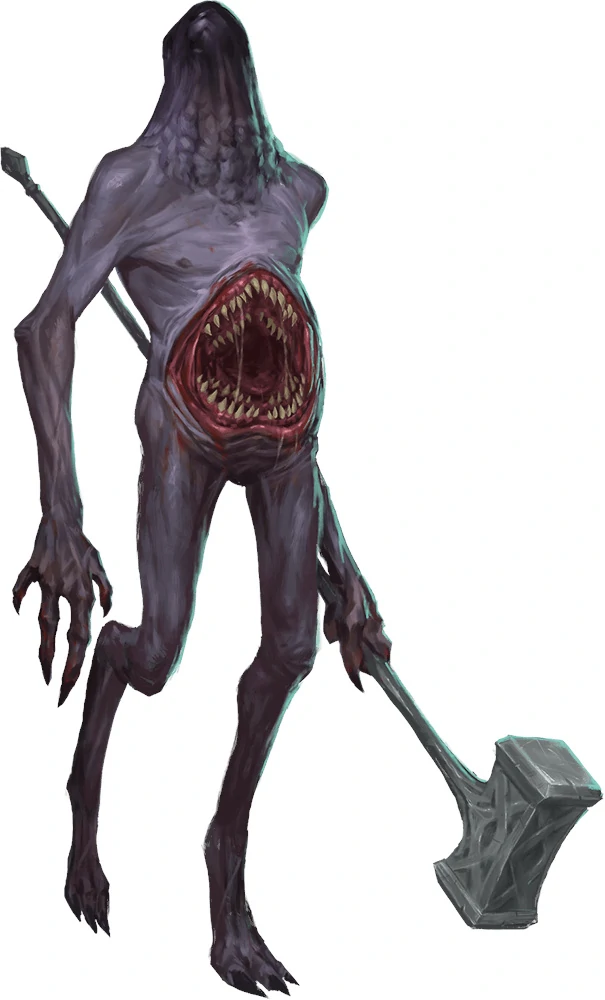
- Book: Icewind Dale
- Challenge Rating: 10
- Inventors: Netherese Empire.
- Method: A fusion of Elemental Earth, Magic, and nine sacrifices
Also known as the Thallud or the faceless.
Tomb tappers are intelligent constructs initially created to seek out the source of a magical drain beginning to spread through their lands and assist the Netheresein in their battle with the Phaerimm.
They were given a lust for magic to hunt for the magical drain’s cause. However, due to their ‘ancestor’s’ jobs and their ‘programmed’ purpose, Tomb Tsappers primarily focus on collecting magic items and the genocide of non-human spellcasters.
Somewhat distressingly, the Faceless inherited the memories of the nine sacrifices used to make them. The Tomb Tappers were typical, if not always, made using ‘volunteers’ from Netherese’s poor districts. These memories were less vivid and more’ recollections.’
A strange shared behavior among the Tomb Tappers was a compulsive need to amuse themselves when not actively hunting magic. This primarily took the form of twisting the rock around them into various shapes.
Warforged Titan & Colossus
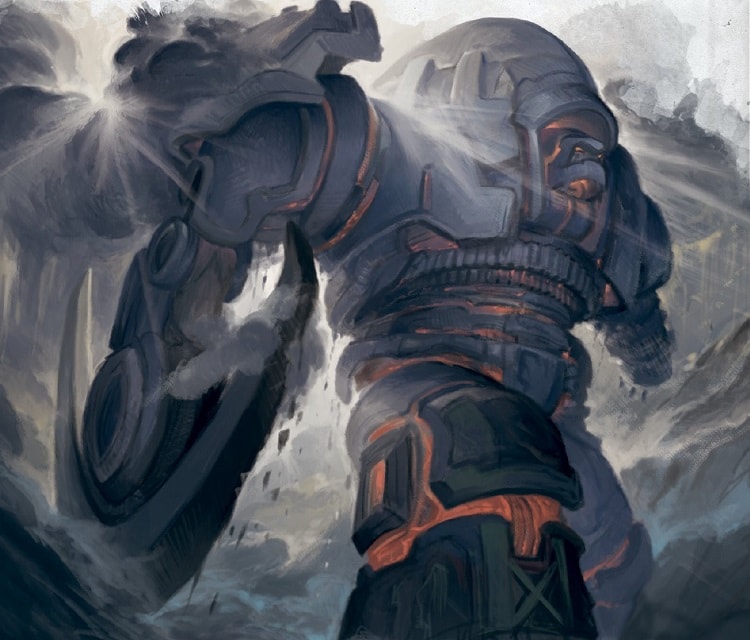
- Book: Eberron: Rising from the Last War
- Challenge Rating: Titan (8), Colossus (25)
- Inventors: Ancient Giants (Original War Golems), House Cannith ( Titan & Colossus)
- Method: Blueprints available from House Cannith
The Warforged Titans are giant, mindless war golems built during the Age of giants. The Giants used these constructs to assist them in battling the Quori many millennia ago. The original Titans were unearthed by House Cannith. They studied and, soon, reverse engineered these war golems, allowing them to invent the Warforged Titan.
During the Last War, the Warforged Titan became known as some of its most feared champions. Their ability to grind destruction pathways is often compared to a Hellfire engine by the armies who faced them.
Read also: Comprehensive Warforged 5e Guide.
Warforged Colossus
House Cannith outdid themselves, however, and massively improved this design. Ultimately, in the final days of the Last War, the Warforged Colossai were unleashed.
Rather than a Hellfire Engine, these champions fought like the Terrasque. Hundreds could be crushed in a few steps.
- Their stomp affects a 20-foot radius for 6d10 bludgeoning damage.
- Not only that, but they have an ‘eldritch turret,’ which is a relatively gentle 4d8 comparatively, but it has a godly 300-foot range.
- Worse, they had been outfitted with horrifying beams capable of 11d10 radiant damage in a 150-foot line.
- Finally, they have a hollow body made to house wizards, artificers, and elite soldiers. They have internal decks, storage areas, observation decks, and tunnels connecting them all.
Most of the War Forged Collossai survive the Last War and its Day of Mourning. They are spread across the Forgotten Realms in stasis, waiting to be awakened. Their current known positions are as follows.
FAQs
Question: Are there any Fun Named Constructs I Can Use in DnD 5e?
Answer: Plenty! I’ll give you my favorite. It’s a creepy jester doll from the book, Curse of Strahd.
Let me quickly tell you about the creation of toymaker Fritz Von Weerg. Pidlwick the Second.
Pidlwick II is a peculiar case because this living doll has some unique backstory. Initially, Pidlwick II was made in the likeness of Duchess Dorfniya Dilisnya’s favorite geat jester, Pidlwick. Reportedly, Strahd didn’t like the Jester but allowed him to join the Duchess in visiting Castle Ravenloft due to amusing others under his service.
Unlike the original, the construct was terrible at the arts of the Jester.
After the Duchess died of illness. The doll spent an unhealthy amount of time stewing about being unable to compete with the real Great Jester. Pidlwick the second pushed Pidlwick the first down the more amusing set of stairs Castle Ravenloft had to offer.
Pidlwick appreciated the murderous Jester, at least.
Question: Have any Other Constructs Found Sapience in 5e DnD?
Answer: Listle Onopordum! This Illusory Living Spell has been living as an Elf for quite some time. Fittingly, Listle became an illusionist in honor of her roots. She is a character in the Forgotten Realms novel: Pool of Twilight.
Question: For DnD 5e, how Can I Use Constructs in My Worldbuilding?
Answer: I will throw together a quick idea for an example!
• The Guild of Innovation would make a terrifying plot bunny for a DM. So let us construct a quick dream team.
• A human with knowledge of Warforged Colossai and Tomb Tappers
• Gnome & Goblin pair knowledgable in general Golems and gizmos.
• Devil with Hellfire Engine experience
• Hag with Animated mount, object, and housing experience
• Toymaker with living doll experience
• Rogue Modron Hierarch with a Skitterwidget farm.
• A Mad Magus Ulitharid wants to steal the Bore Worm while inventing the methods to become the ultimate Elder Brain.
• The Cadaver Collector. Noble puller of the mobile lab, and biological material.
• With these powers combined, you have an adventuring party or a problem worse than Karsus.
Conclusion
As complex melds of ArchMage madness and an engineering degree, D&D Constructs can go well beyond the generic golems and stitched abominations that likely spring to mind. While plenty of Golem types exist to help flavor a campaign, I personally think the most terrifying and unique challenges are constructed by the Outer Planes.
The Cadaver Collectors of Archeron are a perfect introduction to the chaos of the Infinite Battlefield for parties that have cleared that level ten hurdle. Trust me, nothing strikes the curiosity of even the most blood-thirsty of murder hobos like a construct covering itself in corpses like a collector crab.
The Nine Hell’s horrendous Hellfire Engine can set the stage for the soul-shaking power of a devil horde. Nothing sullies celebrations like half of the front lines being shoveled into an infernal train and turned into Asmodeous’ devilish horde.
Should you want to show the devils and wizards who the true masters of creativity are, Players and DMs alike are encouraged to look into Living Spells. With enough convincing, you might be able to hunt down your signature spell and make it into the party mascot!
Just be careful. Mixing the scientific method with magic is all fun and games until the Goddess of Magic gets angry and unleashes the Marut.
Actually, knowing Mystra, that might be just her showing the Arctifers and Wizards how it’s done.
- Blight 5e Guide: Blood-Thirsty Brambles - August 28, 2022
- Constructs 5e Guide: Intimidating Innovation - August 20, 2022
- Modrons 5e Guide - August 13, 2022

